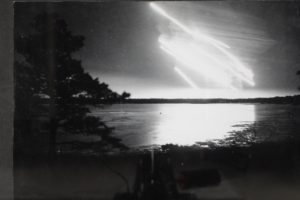Ilmatorjuntamuseo
Barrage fire vs Targeted fire


Picture 1: Barrage fire from 40mm, 20mm and machine gun batteries over Helsinki. SA-kuva.fi
Picture 2: Soviet bombs and illumination bombs falling over the island of Santahamina. Anti-Aircraft museum archives.
The idea in the barrage fire technique was to use as many batteries as possible to produce and ”exploding wall of fire” in front of the attacking planes to deter the pilots from entering the area to be bombarded. Targeted fire, on the other hand, was a technique in which accurate tracking and ranging data were used to achieve a hit on an attacking plane. Radars were essential in the anti-aircraft defence of Helsinki and can be said to have saved the city from total destruction.
Flying through the AA barrage was dangerous and required nerves of steel. In order to increase the deterrent effect the AA shells were modified by boring their fuse holes larger and filling the resulting extra space with a mixture of magnesium powder and aluminium, which intensified the flash of the explosion.
The early warning radars (Raija) were able to detect targets over 100km away. Targets were then passed on to the AA centre and fire-control radars (Irja). Firing data produced by the Irja radars could be used for both barrage firing and targeted firing.
The batteries equipped with Irja radars – there were 4 of them – used mainly targeted firing and the other batteries utilized the barrage technique. The purpose of targeted fire was to select a group of planes and shoot down planes in that group. Most of the planes shot down were hit by guns in the batteries that had Irja radars because they had accurate firing data at their disposal.
The barrage technique was based on a ”flak barrier” fired simultaneously from as many guns as possible. The order to fire the barrage came from the command post and the firing was timed so that the shells fired from the different batteries exploded simultaneously in the desired target area. This produced an impenetrable ”wall of fire” in the sky. As a consequence, the bombers often released their bombs before reaching their designated bomb dropping zone and broke away from the attack.
The firing coordinates were calculated on the basis of the then geographic center of Helsinki, which was at the railway bridge crossing the strait connecting Töölönlahti and Eläintarhanlahti bays. The barrage rings, which were 1km apart, extended 4-14km around the city. The widths of the rings varied from 1000 to 1500 metres depending on the distance of the ring from the center. Each battery calculated the firing data trigonometrically (alignment, elevation and thedelay of the time fure of the shell) for its guns. The elevation angles were calculated at 200m intervals. The barrage targets extented from a height of few hundred meters up to over 7000 metres depending on the gun used. The resulting firing data was recorded in so-called barrage fire books kept in the batteries. These books enabled the men to get the guns ready to fire even when an enemy attack came as a surprise.
